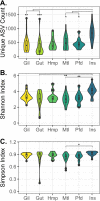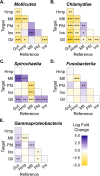Microbiome Analysis Reveals Diversity and Function of Mollicutes Associated with the Eastern Oyster, Crassostrea virginica
- PMID: 33980678
- PMCID: PMC8125052
- DOI: 10.1128/mSphere.00227-21
Microbiome Analysis Reveals Diversity and Function of Mollicutes Associated with the Eastern Oyster, Crassostrea virginica
Abstract
Marine invertebrate microbiomes play important roles in diverse host and ecological processes. However, a mechanistic understanding of host-microbe interactions is currently available for a small number of model organisms. Here, an integrated taxonomic and functional analysis of the microbiome of the eastern oyster, Crassostrea virginica, was performed using 16S rRNA gene-based amplicon profiling, shotgun metagenomics, and genome-scale metabolic reconstruction. Relatively high variability of the microbiome was observed across individual oysters and among different tissue types. Specifically, a significantly higher alpha diversity was observed in the inner shell than in the gut, gill, mantle, and pallial fluid samples, and a distinct microbiome composition was revealed in the gut compared to other tissues examined in this study. Targeted metagenomic sequencing of the gut microbiota led to further characterization of a dominant bacterial taxon, the class Mollicutes, which was captured by the reconstruction of a metagenome-assembled genome (MAG). Genome-scale metabolic reconstruction of the oyster Mollicutes MAG revealed a reduced set of metabolic functions and a high reliance on the uptake of host-derived nutrients. A chitin degradation and an arginine deiminase pathway were unique to the MAG compared to closely related genomes of Mollicutes isolates, indicating distinct mechanisms of carbon and energy acquisition by the oyster-associated Mollicutes A systematic reanalysis of public eastern oyster-derived microbiome data revealed a high prevalence of the Mollicutes among adult oyster guts and a significantly lower relative abundance of the Mollicutes in oyster larvae and adult oyster biodeposits.IMPORTANCE Despite their biological and ecological significance, a mechanistic characterization of microbiome function is frequently missing from many nonmodel marine invertebrates. As an initial step toward filling this gap for the eastern oyster, Crassostrea virginica, this study provides an integrated taxonomic and functional analysis of the oyster microbiome using samples from a coastal salt pond in August 2017. The study identified high variability of the microbiome across tissue types and among individual oysters, with some dominant taxa showing higher relative abundance in specific tissues. A high prevalence of Mollicutes in the adult oyster gut was revealed by comparative analysis of the gut, biodeposit, and larva microbiomes. Phylogenomic analysis and metabolic reconstruction suggested the oyster-associated Mollicutes is closely related but functionally distinct from Mollicutes isolated from other marine invertebrates. To the best of our knowledge, this study represents the first metagenomics-derived functional inference of Mollicutes in the eastern oyster microbiome.
Keywords: Chlamydiae; Mollicutes; Spirochaetia; eastern oyster; metagenomics; microbiome.
Copyright © 2021 Pimentel et al.
Figures




References
-
- Peterson CH, Grabowski JH, Powers SP. 2003. Estimated enhancement of fish production resulting from restoring oyster reef habitat: quantitative valuation. Mar Ecol Prog Ser 264:249–264. doi:10.3354/meps264249. - DOI
-
- Piazza BP, Banks PD, La Peyre MK. 2005. The potential for created oyster shell reefs as a sustainable shoreline protection strategy in Louisiana. Restor Ecol 13:499–506. doi:10.1111/j.1526-100X.2005.00062.x. - DOI
-
- Huanxin W, Lejun Z, Presley BJ. 2000. Bioaccumulation of heavy metals in oyster (Crassostrea virginica) tissue and shell. Environ Geol 39:1216–1226. doi:10.1007/s002540000110. - DOI
-
- Humphries AT, Ayvazian SG, Carey JC, Hancock BT, Grabbert S, Cobb D, Strobel CJ, Fulweiler RW. 2016. Directly measured denitrification reveals oyster aquaculture and restored oyster reefs remove nitrogen at comparable high rates. Front Mar Sci 3:74. doi:10.3389/fmars.2016.00074. - DOI
Publication types
MeSH terms
Substances
LinkOut - more resources
Full Text Sources
Other Literature Sources
Research Materials
Miscellaneous
